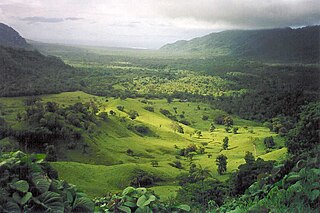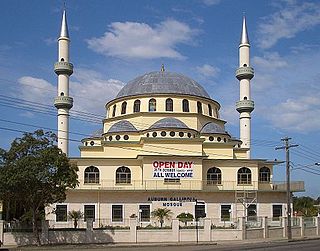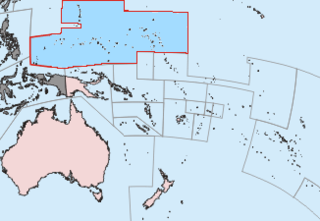 W
WThe Catholic Church in Vanuatu is part of the worldwide Catholic Church, under the spiritual leadership of the Pope in Rome. Catholics constitute 13% of the population of Vanuatu. The church is organized into one diocese based in the capital of Port Vila. The diocese is a member of the Pacific Bishops Conference.
 W
WFalefa Valley is situated inland on the east side of Upolu Island in Samoa. The valley forms part of the traditional domain of Falefa with the southern part at Le Mafa pass forming the natural boundary between Falefa and neighbouring Lotofaga. The area has been excavated and studied by archaeologists, in particular a New Zealand team led by Roger Curtis Green and Janet Davidson. Towards the north of the valley is Falefa village. The valley is situated in the political district of Atua. To the north east is the smaller district of Va'a-o-Fonoti which includes an extensive conservation area.
 W
WGadao's Cave is a rock art site on the United States island of Guam. Located near the village of Inarajan, the cave is the site of a panel of approximately 50 pictographs, painted with a mixture of coral lime and tree sap. The most unusual images are of two human stick figures that appear to be carrying things. It is not known who painted them or when, and what their significance is.
 W
WThe Haputo Beach Site is a prehistoric village site in northwestern Guam. The site, located on United States Navy land near a sheltered cove, includes standing latte stones, as well as rock shelters and caves with evidence of human occupation. In addition to needing military permission for access to the site, the main trail leads through an ecological preserve.
 W
WHatihe'u is a village in Nuku Hiva, in the Marquesas Islands. It lies on the bay of the same name and is also the name of an "amphitheater-shaped valley on the northeast side of the island". An ancient village, the area contains petroglyphs. Archaeologists have identified some 400 different features in the Hatihe'u Valley area.
 W
WHoneycomb Hill Cave is located in the Oparara Basin, on the northwestern edge of the South Island of New Zealand. The Oparara River flows through a section of the cave.
 W
WAmerican Samoa is an unincorporated territory of the United States, located South East of Samoa and consisting of seven main islands. American Samoa is predominately a Christian nation, identifying as a region founded by God, however, has become more religiously diverse since the mid-20th Century. The religion of Islam was first brought to American Samoa in the mid-1980s by Muslim expatriate workers from government programs. The region received their first native convert in 1985, although Muslim adherents still remain a small minority in American Samoan society today. While the population is small, the spread of Islam has been a significant part of the Island’s history. As a result of increased terrorist activities globally in the early 2000s, specifically the Bali bombing which targeted American Samoa’s neighbours, the islands imposed a strict ban on residents of 23 nations from entering their territory without explicit permission from the island’s attorney general’s office. Most of the countries banned were either located in the Middle East and identified as Muslim nations, or were home to a large number of Muslim adherents.
 W
WIslam in Oceania refers to Islam and Muslims in Oceania. By current estimates, there are 620,156 total Muslims in Oceania: 476,600 in Australia, 48,151 in New Zealand, 52,520 in Fiji, 6,352 in New Caledonia, 2,200 in Papua New Guinea, 360 in Solomon Islands, 221 in Vanuatu, 110 in Tonga.
 W
WBefore World War II, the Imperial Japanese Navy began construction of various airfields, fortifications, ports, and other military projects in the islands controlled under the South Seas Mandate. It was from these fortifications in Palau, the Carolines and the Marshall Islands that a significant portion of the Japanese Navy disembarked towards the Philippines, New Guinea, Nauru and the Gilbert Islands during 1941–42 in the Pacific War.
 W
WThe Japanese Jail Historic and Archeological District in Garapan (Saipan), MP, is a historic district that was listed on the U.S. National Register of Historic Places in 2011. The listing included two contributing structures and 15 contributing sites. It includes ruins of a jail that was built in 1930 and was used until 1944.
 W
WThe 6th Micronesian Games were held on Saipan, Northern Mariana Islands from June 23-July 2, 2006. The Games featured competition in 15 different sports/disciplines.
 W
WThe 7th Micronesian Games was held August 1–10 in Palau.
 W
WThe Ministry of Education and Human Resources Development (MEHRD) is the education ministry of the Solomon Islands, headquartered in Honiara.
 W
WThe Orote Historical Complex is a series of prehistoric and historic features at the northern tip of the Orote Peninsula on the island of Guam. This area is on the grounds of Naval Base Guam and requires military permission to see. Major features include Fort Santiago, built by Spanish colonial authorities in the early 18th century to secure Apra Harbor, the so-called "Spanish Steps", which provide access from the fortifications to a well at the base of the cliff, which may actually be of early 20th-century American origin, and a series of rock shelters and caves exhibiting evidence of human occupation to the Pre-Latte Period.
 W
WThe Pindai Caves of New Caledonia are an archaeological and palaeontological site important for the study of prehistoric human settlement as well as of the Holocene fauna of the island. The Pindai area has been occupied by humans for varying periods over the last 2,800 years.
 W
WPuna Pau is a quarry in a small crater or cinder cone on the outskirts of Hanga Roa in the south west of Easter Island. Puna Pau also gives its name to one of the seven regions of the Rapa Nui National Park.
 W
WSapapaliʻi is a village on the north east coast of Savaiʻi island in Samoa. It is the village where John Williams, the first missionary to bring Christianity to Samoa landed in 1830. Sapapali'i is in the Fa'asaleleaga political district.
 W
WThe West Bona Site is an archaeological site near Santa Rita on the island of Guam. It encompasses a prehistoric village site consisting of at least seven latte stone house sites. Most of them are not in good condition, although the largest, with twelve stones, is in good condition. Radiocarbon dating places early occupation of the site to between 1285 and 1435, reaching its height around 1500. The site is on the grounds of Naval Station Guam.
 W
WYali are major tribal group in Papua, Indonesia, and live to the east of the Baliem Valley in the Papuan highlands. The Dani word for "lands of the east" is "yali", from where the Yali took it, without it being a self-identification for their tribe.